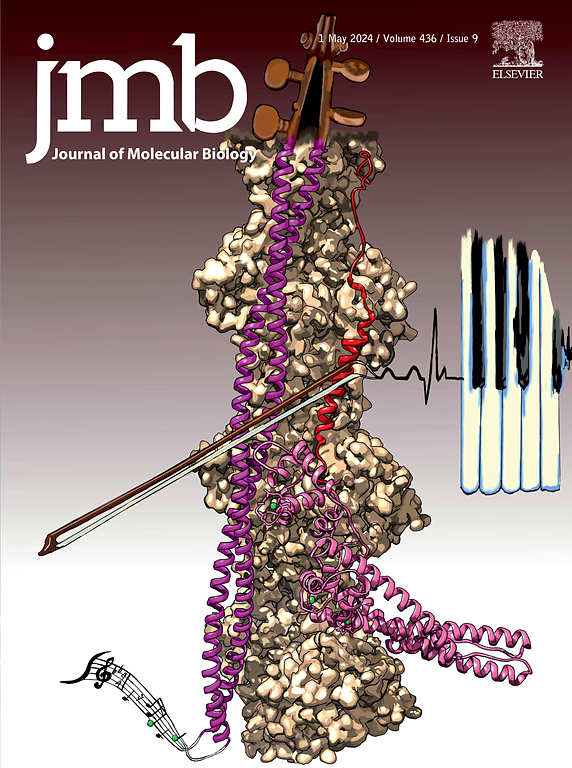重组AβM1-42淀粉样原纤维高效播种脑血管a β-淀粉样变性。
IF 4.7
2区 生物学
Q1 BIOCHEMISTRY & MOLECULAR BIOLOGY
引用次数: 0
摘要
脑内a β-淀粉样斑块和脑淀粉样血管病(CAA)是阿尔茨海默病(AD)和血管性痴呆的病理标志。β淀粉样变性在大脑中的扩散似乎是由一种播种机制介导的,其中预先形成的原纤维(称为种子)通过绕过决定速率的成核步骤来加速β原纤维的形成。一些研究表明,通过注射从转基因小鼠和人类AD大脑中提取的富含Aβ的脑提取物(种子),可以在转基因小鼠中诱导Aβ淀粉样变性,产生人Aβ。然而,对重组种子的研究是有限的。因此,我们研究了不同成分的纯重组人Aβ原纤维的播种活性。3月龄时将种子接种于APP23小鼠体内,培养6个月后进行分析。与未接种相同年龄的转基因对照小鼠相比,含有n端蛋氨酸的a β-肽制备的重组原纤维种子(即AβM1-42、AβM1-40和AβM1-40+AβM1-42预制的原纤维)在体内加速了a β-淀粉样斑块的形成。此外,所有种子均诱导CAA病理。有趣的是,含有AβM1-42种子的AβM1-42比含有纯AβM1-40的种子产生更多的CAA和淀粉样斑块,这令人惊讶,因为APP23小鼠产生的Aβ1-40底物比Aβ1-42多4倍。本研究表明,AβM1-42原纤维在CAA的植入中具有很强的效力,这意味着淀粉样斑块中发生了构象模板,这是通过淀粉样配体染色推断的。我们的研究结果证实重组β原纤维是可传播的淀粉样蛋白,并且与自发的年龄依赖性淀粉样变性相比,体内播种可以加速和重定向β淀粉样变性模式。本文章由计算机程序翻译,如有差异,请以英文原文为准。

Efficient Seeding of Cerebral Vascular Aβ-Amyloidosis by Recombinant AβM1-42 Amyloid Fibrils
Aβ-amyloid plaques and cerebral amyloid angiopathy (CAA) in the brain are pathological hallmarks of Alzheimer’s disease (AD) and vascular dementia. The spreading of Aβ amyloidosis in the brain appears to be mediated by a seeding mechanism, where preformed fibrils (called seeds) accelerate Aβ fibril formation by bypassing the rate-determining nucleation step. Several studies have demonstrated that Aβ amyloidosis can be induced in transgenic mice, producing human Aβ, by injecting Aβ-rich brain extracts (seeds) derived from transgenic mice and human AD brains. However, studies on recombinant seeds are limited. Therefore, we investigated the seeding activity of pure recombinant human Aβ fibrils of different compositions. Seeds were inoculated into APP23 mice at the age of 3 months and were analyzed after 6 months of incubation.
Recombinant fibril seeds made from Aβ-peptides with an N-terminal methionine (i.e. (preformed fibrils from AβM1-42, AβM1-40, and AβM1-40 + AβM1-42) accelerated Aβ-amyloid plaque formation in vivo compared to non-inoculated transgenic control mice of the same age. In addition, all seeds induced CAA pathology. Interestingly, AβM1-42 containing seeds produced significantly more CAA and amyloid plaques than seeds containing pure AβM1-40, which was surprising given that APP23 mice produce approximately four-fold more Aβ1-40 substrate than Aβ1-42.
This study showed that AβM1-42 fibrils are highly potent in seeding CAA and implies that conformational templating occurs in amyloid plaque as deduced by comparative amyloid ligand staining. Our results verify that recombinant Aβ fibrils are transmissible amyloids, and that in vivo seeding can accelerate, and redirect Aβ amyloidosis patterns compared to spontaneous age dependent amyloidosis.
求助全文
通过发布文献求助,成功后即可免费获取论文全文。
去求助
来源期刊

Journal of Molecular Biology
生物-生化与分子生物学
CiteScore
11.30
自引率
1.80%
发文量
412
审稿时长
28 days
期刊介绍:
Journal of Molecular Biology (JMB) provides high quality, comprehensive and broad coverage in all areas of molecular biology. The journal publishes original scientific research papers that provide mechanistic and functional insights and report a significant advance to the field. The journal encourages the submission of multidisciplinary studies that use complementary experimental and computational approaches to address challenging biological questions.
Research areas include but are not limited to: Biomolecular interactions, signaling networks, systems biology; Cell cycle, cell growth, cell differentiation; Cell death, autophagy; Cell signaling and regulation; Chemical biology; Computational biology, in combination with experimental studies; DNA replication, repair, and recombination; Development, regenerative biology, mechanistic and functional studies of stem cells; Epigenetics, chromatin structure and function; Gene expression; Membrane processes, cell surface proteins and cell-cell interactions; Methodological advances, both experimental and theoretical, including databases; Microbiology, virology, and interactions with the host or environment; Microbiota mechanistic and functional studies; Nuclear organization; Post-translational modifications, proteomics; Processing and function of biologically important macromolecules and complexes; Molecular basis of disease; RNA processing, structure and functions of non-coding RNAs, transcription; Sorting, spatiotemporal organization, trafficking; Structural biology; Synthetic biology; Translation, protein folding, chaperones, protein degradation and quality control.
 求助内容:
求助内容: 应助结果提醒方式:
应助结果提醒方式:


